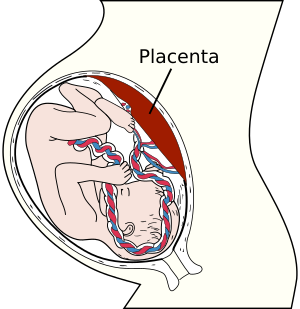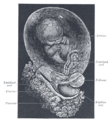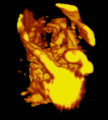Placenta facts for kids
The placenta is a special, temporary organ that grows inside female mammals (like humans) when they are pregnant.
It connects to the growing baby (called a fetus) through the umbilical cord. This cord is full of tiny blood vessels and other tissues. After the baby is born, the placenta comes out too. That's why it's sometimes called the afterbirth.
Contents
How the Placenta Works
Keeping Blood Separate
A very important job of the placenta is to keep the mother's blood and the baby's blood separate. The placenta acts like a special filter. It lets good things pass through, but it stops the blood from mixing directly.
Nutrients and oxygen from the mother's blood move across the placenta to the baby. Waste products from the baby move back to the mother's blood to be removed. This happens through a process called diffusion. If the mother's and baby's blood mixed, it could be dangerous for both, especially if they had different blood types.
The Placental Barrier
The placenta has two main parts. One part comes from the baby, and the other part comes from the mother. It attaches to the inside wall of the uterus (the mother's womb). Here, it gets nutrients and oxygen from the mother's blood. It also helps remove waste from the baby.
This connection forms a special filter called the placental barrier. This barrier helps protect the baby from some harmful things.
However, the placental barrier cannot block everything that might hurt the baby. For example, certain substances can still pass through. This is why it's important for pregnant people to be careful about what they consume. Some chemicals that can cross this barrier and harm the baby are called teratogens.
Also, some infections can pass through the placenta and affect the baby.
Placenta in Other Animals
Not all mammals have the same kind of placenta as humans.
- Egg-laying mammals (like the platypus) and marsupials (like kangaroos) have a different type of placenta. Their placenta mostly gets nutrients from the egg sac, not directly from the mother's blood.
- Some snakes and lizards have also developed a system similar to a placenta for their babies inside them. This is an example of convergent evolution, where different animals develop similar features independently.
Images for kids
See also
 In Spanish: Placenta para niños
In Spanish: Placenta para niños








